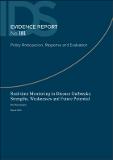| dc.contributor.author | Ramalingam, Ben | |
| dc.coverage.spatial | Ethiopia | en |
| dc.coverage.spatial | Sierra Leone | en |
| dc.date.accessioned | 2016-03-09T11:29:22Z | |
| dc.date.available | 2016-03-09T11:29:22Z | |
| dc.date.issued | 2016-03 | |
| dc.identifier.citation | Ramalingam, B. (2016) Real-time Monitoring in Disease Outbreaks: Strengths, Weaknesses and Future Potential, IDS Evidence Report 181, Brighton: IDS | en |
| dc.identifier.uri | https://opendocs.ids.ac.uk/opendocs/handle/20.500.12413/9940 | |
| dc.description.abstract | This Evidence Report analyses the potential contribution of epidemic real-time monitoring (ERTM) initiatives to enhancing and augmenting disease surveillance systems in developing countries.
It gathers and synthesises existing evidence from literature on infectious diseases, case study evaluations and expert viewpoints about how a range of ERTM initiatives have been used for, and added value to, epidemic early warning and early response efforts.
By drawing on a range of insights from academic literature, organisational evaluations and practitioner perspectives, the study aims to provide a rounded picture of the potential as well as the limitations of real-time data for epidemic disease responses. | en |
| dc.description.sponsorship | UK Department for International Development | en |
| dc.language.iso | en | en |
| dc.publisher | IDS | en |
| dc.relation.ispartofseries | IDS Evidence Report;181 | |
| dc.rights.uri | http://creativecommons.org/licenses/by/3.0/ | en |
| dc.subject | Health | en |
| dc.subject | Technology | en |
| dc.title | Real-time Monitoring in Disease Outbreaks: Strengths, Weaknesses and Future Potential | en |
| dc.type | IDS Evidence Report | en |
| dc.rights.holder | IDS | en |
| dc.identifier.ag | OT/11009/7/2/3/583 | |


